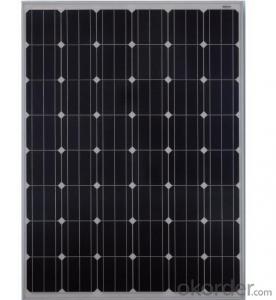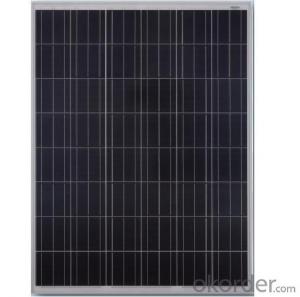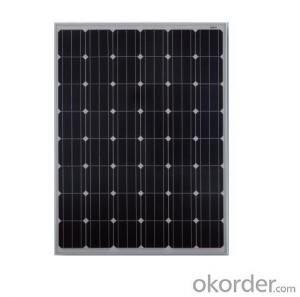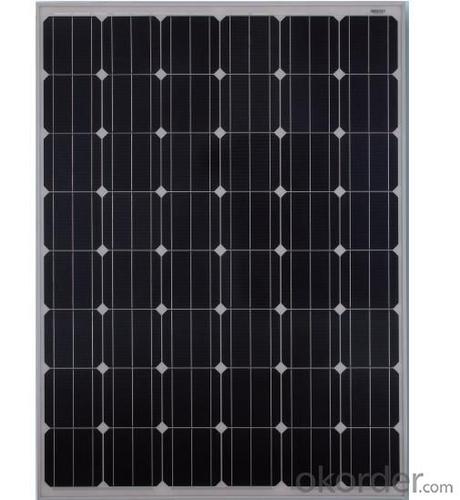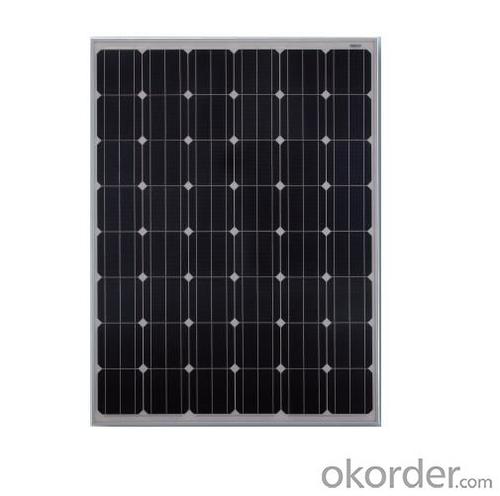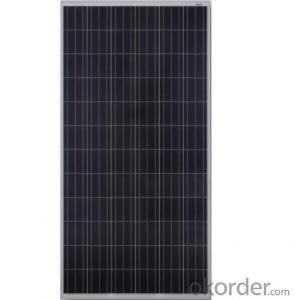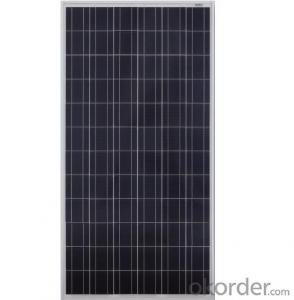Mono Panel Jam6 48 215W Electric Cars Solar Panels
OKorder Service Pledge
OKorder Financial Service
You Might Also Like
JAM6 48 200-220W MONOCRYSTALLINE SILICON MODULE
Key futures:
monocrystalline modules designed for residential and utility applications,rooftop or ground mount.
the latest module manufacturing technology,high power output and highest conversion effciency of 16.39%
Anti-reflective and anti-soiling surface reduces power loss from dirt and dust;
outstanding prformance in low-light irradiance environments;
excellent mechanical load resistance:certified to wothstand high wind loads (2400pa)and snow loads(5400pa)
high salt and ammonia resistance certified by TUV NORD
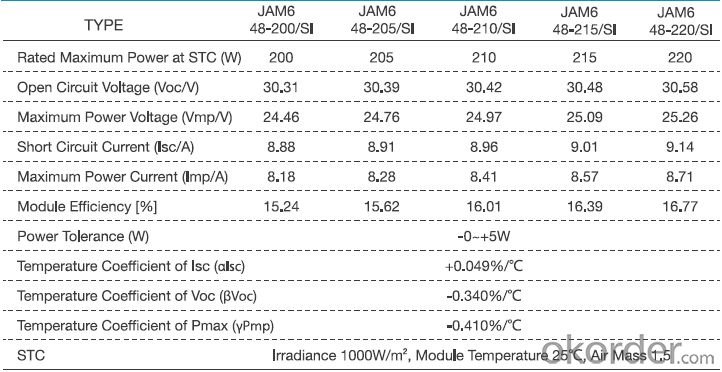
- Q: How do solar panels affect the overall resilience of a building?
- Solar panels can greatly enhance the overall resilience of a building by providing a reliable and sustainable source of electricity. By generating clean energy from the sun, solar panels reduce dependency on traditional power grids, making the building less susceptible to power outages and fluctuations. Additionally, solar panels can continue to operate during extreme weather events, ensuring a constant power supply. This increased energy independence and stability make the building more resilient and better equipped to withstand challenges and disruptions.
- Q: Well I was thinking about the idea of renovating either a smaller school bus or building a tiny house and I was wondering if i can get some information on the size and watts panel should I use or more like how to get that whole solar energy in motion. Any infor and links would help
- I think that typical solar panels are 2'x4' and produce something like 800-000 wh per day. (That's 0.8 - kwh per day.) More in the summer, less in the winter, if they're aimed sort of at the sun. There are newer, more expensive panels that produce more. There are also thin film panels that are less expensive, and probably more sturdy. You then have a couple choices. In a house, you'd have an expensive inverter to connect to the utility power, so you can have power at night when your panels aren't generating anything. In a trailer, you want 2-4-6 deep cycle car batteries to store the power. Then you could have an inverter to convert that power to 20v AC, so you could use normal appliances. Or, you could buy appliances that run on 2 volts DC. Maybe a combination of both. You'll need to figure out how much power you're going to use, so you know how many panels and batteries you're going to need. The calculation is easy. Figuring out how much power you need is hard. You need deep cycle batteries because you can repeatedly charge them way up and run them way down. Ordinary batteries die fairly quickly when you do that.
- Q: Can solar panels be used for powering traffic lights?
- Yes, solar panels can be used to power traffic lights. Solar panels convert sunlight into electricity, which can be used to power various devices, including traffic lights. This allows for a sustainable and renewable energy source for traffic signals, reducing reliance on traditional power grids and minimizing environmental impact.
- Q: Can solar panels be installed on factories or industrial buildings?
- Yes, solar panels can be installed on factories or industrial buildings. In fact, it is quite common for large-scale solar installations to be implemented on such structures, as they often have expansive rooftops or open spaces suitable for maximizing solar energy generation. Installing solar panels on factories or industrial buildings can help offset power consumption, reduce carbon emissions, and provide a sustainable source of energy for these facilities.
- Q: our school spends around $0,000 dollars on energy.we want to know how much money would installing solar panels on the roof save our school.
- even although photograph voltaic panels cost quite some funds up front and don't furnish a hundred% performance, over the existence of the device, a photo voltaic panel array can shop maximum folk funds. producers furnish 25 365 days production guarantee on panels and panels will often proceed to supply after the guaranty has expired. whilst a device is designed to supply 'internet metering' truly producing as a lot power a house makes use of it (the two by way of batteries or pushing it back on the grid the payback on the cost of the panels would be measured by way of dividing the device cost by way of the month-to-month power expenses. With the passage of a 30% federal tax credit on qualified platforms and assorted state classes, platforms will payback often in under a decade consistent with utilization factors and climate.
- Q: I want to buy a solar panel from my house and I want to know how much it costs, what I have to buy and everything I need to know
- Guide okorder /
- Q: I hooked up a 2V solar panel to a small relay. The relay switches at 9V. When I have light shining on the panel it puts out aorund 3-4V, but when I hook it up directly to the relay it drops to V and doesn't switch the relay. Why? and How do I fix it?-2V Mono-Crystalline Solar Panel -JWD 7 4 reed relay
- Do you know what is the rated Peak watts of the solar cell and the current needed to operate the relay. The power needed to operate the relay can be found from 9V * operating current, and that should be lower than the peak output power of the cell (perhaps significantly less as the peak power is produced only at high solar radiation levels. Another factor is whether the curves for the solar cell match the load. Typically the solar cells have a knee type diagram for the VI relationship, and that is why they need Maximum Power Point trackers to deliver a good power output.
- Q: I'm looking for some advice on hot water solar panels. I'm trying to save some money on electricity. A neighbor has been suggesting solar powered equipment for some time now, and I think he's right. It does save quite a bit of money in the long run. They're kind of expensive though, so I'm looking for cheaper alternatives.
- I worked for a plumbing service that offered hot water solar panel installs and replacements. I've replaced perfectly good solar panels for people who wanted to upgrade to the latest. We had piles and piles of panels out behind the shop. We use to scrap the copper and sell the glass panes. A few people would ask to scavenge panels and the boss would let them have it cheap, just to move some of the stuff. I would do the same. I'd find a local installer and see what they do with the leftovers. Chances are, if you searched diligently, you could probably find panels in good shape and use them to supplement your energy usage. Bear in mind, solar hot water system are very different from standard systems. They usually have a much larger storage tank. Typically 80-20 gallons compared to 40. They have a circulating pump and temperature sensors to move the heated water from the panel into the tank. These larger hot water heaters/tanks have much better storage and insulation to keep the water temperature that is generated during the day to last into the evening when people are home to use the shower and wash clothes to take advantage of solar heat. It's not just a matter of getting a panel and slapping it up. There's are technical aspects that need to be followed and if you don't know them, I would advise against doing it yourself. Study up on it and see if it's something you want to tackle on your own before you go too far doing legwork to find out details that might be cost prohibitive or too complicated. Good luck.
- Q: How do solar panels perform in cloudy weather?
- Solar panels can still generate electricity in cloudy weather, although their performance is reduced compared to sunny conditions. The panels are able to convert diffuse sunlight into electricity, but the amount of energy produced will be lower.
Send your message to us
Mono Panel Jam6 48 215W Electric Cars Solar Panels
OKorder Service Pledge
OKorder Financial Service
Similar products
Hot products
Hot Searches
Related keywords
